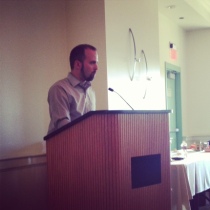Earlier this week, I sat at the Wood Tick table at Camp Read-a-Lot. Fortunately, there were no actual wood ticks. Just teachers, librarians, and books. Lots of books. I started the morning by standing up in front of everyone and talking about books. I made sure to wiggle my toes and listen for background sounds to calm my nerves as a friend had suggested. I hope it worked. It was all a bit of a blur, to be honest.
The real memorable Camp moments were later when William Alexander took the stage. Here is a writer who knows what stories can do. He spoke of the contradictory way people perceive fantastic fiction–it’s silly or foolish, but it’s also dangerous. Not unlike the way comic books or video games are often perceived. As a culture, we keep fighting over fiction without taking into account that we are wired for storytelling. We need stories–foolish and serious. Kids, especially, need stories of all sorts as they work out the intricacies of their worlds.

At this point in the presentation, I was live tweeting as quickly as I could. Eventually I stopped trying to tweet it all, but not before he thanked librarians and teachers for perpetuating the love of reading aloud. He said, “Read aloud always. Learn what delicious language tastes like.”
I have to admit, I haven’t read Goblin Secrets. Even after it won the National Book Award for Young People’s Literature, I didn’t give it a chance. Frankly, it’s rare that I pick up a fantasy novel. But I have been won over. In this PW interview Alexander said, “The thing about all stories, really, but especially about fantasy, is that they have the potential to throw our basic assumptions about ourselves into question.” Perhaps it’s time I gave the genre another chance.







